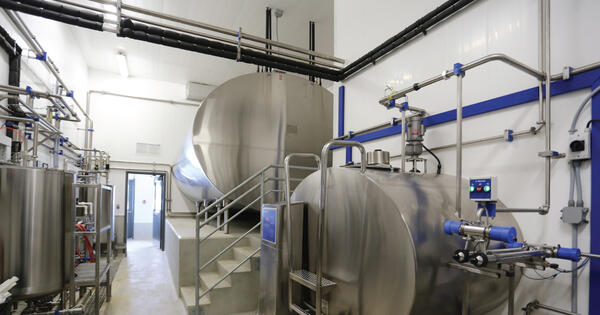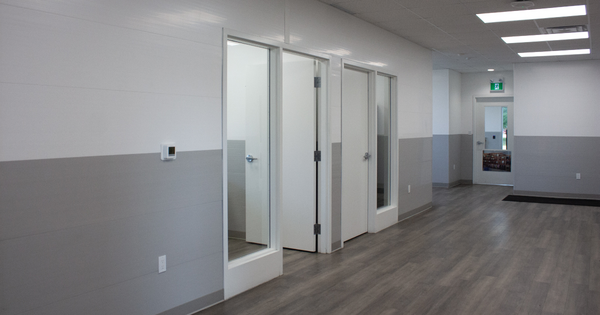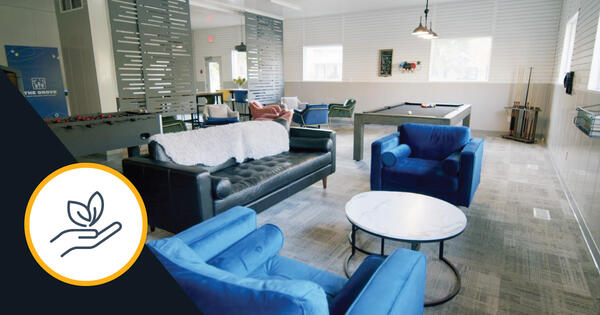This post was originally published in November 2021. Last updated: July 2025.
Choosing the right wall material is one of the most important decisions you’ll make when building or upgrading a grow room. While lighting systems, climate control, and plant nutrition tend to get most of the attention, the surfaces that surround your grow operation play a critical role in long-term success.
In an indoor grow room, walls are constantly exposed to high humidity, moisture, and plant residue. If your wall material can’t handle these conditions, it can lead to serious problems — like mold, mildew, warping, or bacterial contamination. These issues aren’t just cosmetic. They can affect plant health, lead to regulatory failures, and force costly repairs or shutdowns.
Most grow rooms today are built with one of a few common materials:
- Drywall coated with paint or epoxy: Easy to install and inexpensive for at-home grow rooms or smaller operations, but prone to mold and moisture damage unless meticulously sealed.
- Fiberglass Reinforced Plastic (FRP): A more durable alternative that’s often used in food-processing or agricultural settings.
- PVC-based wall panels: Growing in popularity thanks to their durability, cleanability, and moisture resistance.
Each option has its pros and cons, but not all of them are designed for the kind of high-performance environment an indoor grow room demands. That’s why it’s worth taking a closer look at how these materials stack up — especially when it comes to FRP versus PVC.
What Are FRP Panels & Why Are They Commonly Used in Grow Rooms?
FRP panels are composite wall coverings made by embedding fiberglass into a plastic resin. The result is a rigid, semi-flexible panel that’s lightweight and relatively strong. They’re usually installed over a solid backing like OSB or drywall using adhesives and plastic moldings to cover seams.
For indoor grow room owners who are looking to protect their walls from splashing water, frequent cleaning, and constant exposure to moisture, FRP can seem like a logical step up. It’s moisture-resistant, relatively easy to wipe down, and more impact-resistant than painted drywall. Plus, it’s been widely used in commercial kitchens, wash bays, and food facilities
That’s why it’s become a go-to for many growers: it’s familiar, available, and generally meets the minimum requirements for a damp environment. But minimum requirements don’t always translate to long-term performance — especially in a space where cleanliness, durability, and uptime are everything.
FRP Panel Limitations in Indoor Grow Rooms
FRP panels might work well enough for lower-demand environments, but grow rooms push materials to their limits. And when you take a closer look, FRP shows some major weaknesses, especially over time.
One of the biggest concerns is moisture resistance. While FRP panels are marketed as moisture-tolerant, they don’t perform well under continuous humidity. Over time, water can seep behind the panels through seams or damaged edges, leading to:
- Mold and mildew growth: Once moisture gets trapped between the panel and the substrate, it creates a breeding ground for mold.
- Delamination and warping: The bond between the fiberglass layer and plastic resin can start to break down, especially if the substrate swells.
- Stained or bubbling surfaces: Repeated exposure to moisture can cause visible defects that are hard to fix without replacing entire panels.
Installation is another pain point. FRP panels require adhesives, trim moldings, and a dry, smooth substrate to install properly. That adds time, cost, and labor to any grow room build. And if you ever need to make repairs or install additional equipment, cutting or patching FRP can be awkward and time-consuming.
There are also hygiene concerns to think about:
- Seam integrity issues: FRP seams are usually finished with plastic moldings that can crack or shift over time, creating spaces where bacteria and grime collect.
- Hard-to-clean edges and corners: Because the material isn’t fully sealed or seamless, it’s harder to sanitize thoroughly — which can be a problem in a grow room where cleanliness is everything.
Put simply, FRP panels weren’t designed with high-humidity, tightly controlled environments in mind. While they may seem like a durable option at first glance, their long-term performance in an indoor grow room leaves a lot to be desired.
Why PVC Wall Panels Are Better for Grow Rooms
When it comes to creating a high-performing indoor grow room, PVC wall panels are a smarter, more resilient alternative to FRP. They’re designed to stand up to the specific challenges growers face every day — from constant humidity and temperature fluctuations to strict sanitation protocols.
PVC panels are inherently moisture-resistant. Unlike FRP, they’re made from a solid, non-porous material that won’t swell, warp, or grow mold — even after years of exposure to high humidity. There are no paper backers or resins that can delaminate over time, which means you get consistent performance for the long haul.
They also offer a smooth surface that makes cleaning quick and easy. Whether you’re wiping down after a harvest or pressure washing between cycles, PVC panels stand up to repeated washdowns without breaking down or absorbing chemicals.
Here’s why PVC wall panels are better suited to grow room environments:
- Superior moisture and mold resistance: PVC doesn’t absorb water or support mold growth, even in extreme humidity.
- Easy cleaning and sanitation: The smooth, non-porous finish won’t trap dirt or bacteria, helping you maintain a clean and compliant facility.
- Quick installation: PVC panels are lightweight and interlock with tongue-and-groove joints, eliminating the need for adhesives or complex trim systems. However, a bit of silicone is recommended between panels for extra security and for regulatory compliance.
- No risk of delamination: Since the material is solid and homogeneous, it won’t separate, peel, or bubble over time.
- Cost savings over time: While PVC may cost more up front than FRP, the reduced maintenance, faster install, and longer lifespan can lead to significant long-term savings.
PVC wall panels aren’t just a more durable solution — they’re a better investment in the productivity and compliance of your indoor grow room.
Spotlight on Trusscore Wall&CeilingBoard: A Purpose-Built PVC Solution for Grow Rooms
If you’re looking for a PVC wall panel that’s truly designed for the unique challenges of an indoor grow room, Trusscore Wall&CeilingBoard is your answer. Unlike generic PVC or overbuilt FRP options, Trusscore offers a high-strength, hygienic solution that installs fast, performs reliably, and lasts for decades — even in high-humidity environments.
Trusscore Wall&CeilingBoard is made entirely from PVC and features a unique internal truss design that delivers strength without extra weight. It’s impact-resistant, abrasion-resistant, and can be installed directly over studs, drywall, or even existing FRP — no backers or messy glue required. That means you can retrofit your facility quickly and with fewer installers, all while reducing labor costs.
Here’s what sets Trusscore apart from other panel systems:
- Airtight tongue-and-groove system: Panels interlock and hide fasteners for a clean, professional finish that blocks moisture intrusion and makes sanitation easier.
- 100% water and mold resistance: Made from PVC with no organic material, the panels will never absorb moisture, swell, delaminate, or support mold growth.
- Antimicrobial protection: Third-party testing (ISO 846:2019) confirms that Trusscore resists mold, bacteria, and virus growth — critical in high-humidity grow rooms.
- High light reflectivity: With a reflectivity value of 0.90, the bright white surface maximizes the reach of grow lights, supporting healthier plants and reducing lighting costs.
- Low-VOC and Class A fire-rated: Helps support better indoor air quality and safety, meeting requirements for regulated facilities and GMP compliance.
- Simple maintenance: The smooth, non-porous surface resists staining and cleans easily with just soap and water. No harsh chemicals required.
- Quick availability: With North American-wide distribution and short lead times, Trusscore can be on-site fast to keep your grow room build on schedule.
And if your grow room layout includes veg, flower, clone, or extraction areas that need to be divided, NorLock by Trusscore offers a modular, freestanding partition solution made from the same cleanable, durable PVC.
Whether you're expanding an operation or starting from scratch, Trusscore Wall&CeilingBoard is purpose-built to meet the needs of modern indoor grow rooms and outlast the buildings they’re installed in.
Comparing Trusscore and FRP: A Side-by-Side Breakdown
When it comes to choosing between FRP and Trusscore for your indoor grow room, the differences go well beyond surface-level. Here's how the two materials compare across key performance areas that matter most in high-humidity, compliance-driven environments:
| Category | FRP Panels | Trusscore Wall&CeilingBoard |
|---|---|---|
| Material Composition | Fiberglass sheet bonded to a paper or OSB substrate with adhesive | Solid PVC with internal truss design — no backer or adhesive needed |
| Moisture Resistance | Moisture-resistant surface but penetrable seams and organic backers | 100% waterproof — will never swell, delaminate, or trap moisture |
| Mold & Mildew Resistance | Mold can grow behind panels if moisture reaches the substrate | Antimicrobial and mold-resistant (ISO 846:2019 tested) |
| Cleaning & Sanitation | Cleanable with mild detergents; seams and textures can trap debris | Smooth, non-porous surface withstands pressure washing and sanitizing agents |
| Light Reflectivity | Reflective (LR values vary by manufacturer, typically 0.70–0.89) | High reflectivity (0.90 LR) for optimized grow light efficiency |
| Fire Performance | Varies by product — typically Class C | Class A fire-rated with ASTM E84: Flame Spread Index 10, Smoke Developed Index 380 |
| Installation Process | Multi-step installation process with glue, trim, backers, and multiple installers | Installs with screws and common tools — no glue, backer, or skilled labor needed |
| Installation Surface | Requires a smooth substrate like drywall or OSB | Can be installed over studs, drywall, OSB, or existing FRP |
| Time to Install | Slower — often takes days and multiple laborers | Installs up to 2x faster with fewer installers |
| Installed Cost | Higher — requires more labor, materials, and time | ~33% lower installed cost due to faster, simpler install |
| Repair & Retrofit | Difficult to cut and patch cleanly | Easy to modify, cut, or retrofit with standard tools |
| Durability | Prone to delamination, cracking, or bubbling over time | Impact-resistant, abrasion-resistant, designed to outlast the building |
| Indoor Air Quality (IAQ) | Glue used during install can emit VOCs | Low-VOC compliant, including low formaldehyde |
| Regulatory Compliance | Varies by manufacturer — may meet FDA/USDA/CFIA requirements | Meets FDA, USDA, CFIA, and cGMP facility standards |
| Sustainability | Difficult to recycle due to mixed materials and adhesives | 100% recyclable and can be recycled up to 7 times |
When you compare them side by side, PVC clearly offers the performance and durability that indoor grow rooms need — without the maintenance headaches of FRP.
Real-World Considerations for Grow Room Owners
Beyond specs and materials, it’s important to think about how your wall panels will actually perform in the day-to-day operation of your grow room. Conditions in these environments are tough — and not every material can keep up.
Grow rooms deal with high humidity, constant temperature swings, and bright, often intense lighting. PVC wall panels are built to handle those challenges without breaking down. They won’t fade, crack, or buckle under grow lights or heat, and they maintain their structural integrity even after repeated exposure to moisture and temperature changes.
Frequent cleaning and sanitation are also a reality in any serious grow operation — especially for those following GMP or similar quality standards. PVC makes it easier to stay compliant:
- Chemical resistance: PVC panels hold up to common cleaning agents and disinfectants without staining or degrading.
- Hygienic surface: The non-porous finish doesn’t absorb contaminants or organic matter, helping you keep pathogens out.
- Reduced downtime: With no flaking or peeling, there’s less risk of contamination and fewer repairs that slow down your workflow.
Making the right wall material choice isn’t just about building a grow room that works — it’s about building one that works long term, with less hassle and more uptime. PVC wall panels offer the reliability and performance that growers need to stay productive, compliant, and ahead of problems before they start.
Wall and ceiling materials might not be the first decision you make when planning your indoor grow room, but they’re one of the most important for long-term performance. A poor choice — like FRP that delaminates or traps mold behind its seams — can lead to product loss, failed inspections, and costly rebuilds.
Trusscore Wall&CeilingBoard offers a better solution. It installs faster, performs better, and lasts longer than FRP all while helping you meet sanitation standards, maintain GMP compliance, and get more from your lighting investment.
If you’re still using FRP, it may be time to upgrade.
Explore how Trusscore can help you build a more efficient, compliant grow room — one that’s clean, productive, and built to last.






